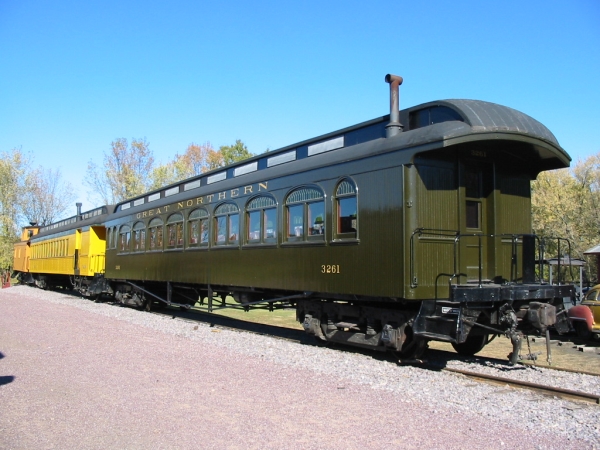Illinois Central--Passenger Train: Passenger Car
This series was created to celebrate my thousandth find and to say thank-you to the many cachers who have placed the caches that have given me such enjoyment. This series is especially inspired by imcgisme’s Beefies series and brainandbraun’ Whimsical Tales series with some help from rcflyer2242’s caches. The series is also designed with beginning cachers and especially kids in mind. All hides should be very easy and I hope that the cache containers help make it fun for kids of all ages. Families with small children and folks with complaining joints should note that the terrain for the passenger train series is straight forward and should not present much trouble. However, the terrain for the freight train series is varied. The railroad embankment near the beginning of the train is high and fairly steep, especially for the tender and tank car. These numbers should be pretty easy to guess, so it is possible to find the mystery train without climbing to these caches. Occasionally it might not be obvious where to find the log on the container. In these cases a hint will guide you. On the outside of each cache container is a series of numbers. Be sure to record the ones digit as you will need it to find the final: Mystery Train--At the Station. For example, if the number on the outside of the cache container reads 123, you would need to record the number 3.
The Badger State Trail runs on the former bed of the Freeport to Madison line of the Illinois Central. The line was originally constructed for the CM&N Railroad running from Freeport Illinois to Madison Wisconsin. It was completed in 1888 with the first train making the run on February 1, 1888. The final run was made in 1991. As part of the state of Wisconsin's Rails to Trails program, the Badger State Trail opened in 2007 with the final paved section from Purcell Road north to Madison opening in 2010. Click here for more information on the Badger State Trail.

The Passenger Car
The first passenger trains traveled only short distances and thus passenger comfort was not as critical as it later became with longer trips. In England, the first passenger cars simply provided a roof and a floor with small holes which allowed rain to drain away. Passengers were expected to stand for the duration of the trip. In America, the earliest passenger cars were modeled on the stage coach. Passenger cars were short, often less than ten feet in length. However, during the mid-19th century the increasing volume of passenger traffic as well as the cry for greater passenger comfort drove innovation in passenger car technology. These developments in America and Europe proceeded along separate paths. In America, the coach style of passenger car dominated with passengers riding in a single long open cabin with rows of seats and doors at either end of the car. In Europe, the compartmentalized style dominated. Passengers would enter separate compartments from a side door which opened onto a corridor or to the outside of the car. During the 19th century, most passenger cars were made of wood. While often beautifully constructed, these cars could catch fire and were prone to “accordion” in the event of a collision. The early twentieth century saw the introduction of all steel cars which were lighter than the wooden cars, stronger, and less prone to catch fire. Increasingly railroads and passenger car manufactures competed to offer ever greater amenities to passenger cars. This development peaked in the “golden age” of rail travel between 1930 and 1950. In subsequent years, developments in the United States have focused on increasing the carrying capacity of passenger cars now most frequently used to carry commuters. One such development was the double deck passenger car. In the Europe, development focused on innovations that would allow passenger trains to travel at faster speeds. Much attention was given to technology which would allow the car to tilt counter to the centrifugal force the car experienced proceeding through a curve. This ability allows cars to safely travel through curves at increasingly higher rates of speed. High speed passenger trains are also increasingly being constructed of trainsets in which cars share common trucks and thus cannot be easily separated.
The Train Cars are on the track from approximately March 15 to November 15.
They are replaced by bison tubes for the winter.
The Geocache Notification Form has been submitted to Steven Johnston, Badger State Trail Manager of the Wisconsin DNR. Geocaches placed on Wisconsin Department of Natural Resource managed lands require permission by means of a notification form. Please print out a paper copy of the notification form, fill in all required information, then submit it to the land manager. The DNR Notification form and land manager information can be obtained at: http://www.wi-geocaching.com/hiding
.